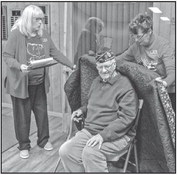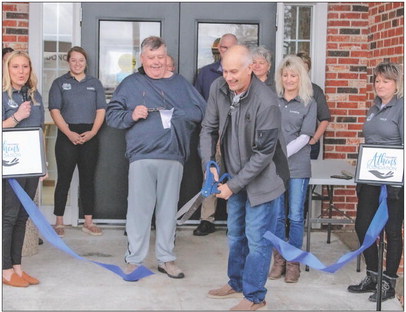Permit for winter manure spreading to be considered


By Kevin O ’Brien
Marathon County staff have been directed to develop a new permit and propose restrictions for farmers who want to spread manure on their fields during the winter months, a practice that is responsible for large amounts of phosphorus entering local waterways.
Following a lengthy discussion with county conservationist Kirstie Heidenreich at its Nov. 5 meeting, the Environmental Resources Committee agreed to have staff at Conservation, Planning and Zoning (CPZ) start working on a winter spreading permit modeled off one currently required in Dane County. CPZ staff will also start drafting new winter spreading restrictions for the committee to consider at a future meeting.
Last week’s discussion was a follow-up to a presentation made to the ERC in September, which featured photos of neon-green algae blooms running along the beaches at Big Eau Pleine Park late last summer. At that meeting, Heidenreich told ERC members that years of efforts to curb algae-feeding phosphorus have fallen short of protecting the Big Eau Pleine Reservoir against largescale contamination.
As a lead-off to last week’s discussion, Heidenreich said the Eau Pleine Partnership of Integrated Conservation (EPP1C) has submitted a grant application to the DNR in order to start an incentive program in 2025 for farmers who agree to implement certain conservation practices, such as stopping winter spreading. A $50 per acre payment would be offered to any farmer who adopts these practices for the first time and signs a four-year contract.
Heidenreich continued to drive home the impact of not doing enough to prevent manure from running off farm fields and into creeks, streams and rivers. She said CPZ staff collects water samples twice a month at the headwaters of the Big Eau Pleine River in Taylor County and at three spots within the Fenwood Creek watershed, and the results See WINTER SPREADING/ page 3 Winter spreading
Continued from page 1
consistently show phosphorus levels at three to four times the state limit of .075 liter per milligram.
Two samples taken during the summer of 2023 showed phosphorus levels 55 times higher than the standard, she added.
By stopping winter spreading – at times when the ground is frozen and unable to absorb manure – Heidenreich said the county would see an estimated 250 to 360 percent reduction of phosphorus entering the Big Eau Pleine watershed.
To see what other counties are doing to reduce phosphorus runoff, Heidenreich said she called around to her colleagues across the state and discovered that only a few of them require permits for farmers to spread manure during the winter.
One of those is Dane County, which has had a permit requirement in place since 2006 that applies to farms of all sizes and covers both liquid and solid manure spreading. Heidenreich said the permit requires farmers to follow NRCS 590 standards, federal guidelines regarding when and how much manure to spread to minimize environmental impacts.
Heidenreich said most of Marathon County’s farmers already follow the 590 standards, with 60 percent operating under nutrient management plans that specify when and how much manure to spread at different times of the year. She noted that Dane County does spot checks on a quarter of all permit holders every February, which is the start of the riskiest time of year for runoff events.
Only three other counties in Wisconsin – Kewaunee, Manitowoc and Door – regulate winter spreading, she said, but she’s confident that Marathon could join that list based on its history of passing progressive policies such as mine reclamation rules later adopted by the state.
Still, Heidenreich said public outreach is needed before any new policies are enacted, so she and other CPZ staff plan on reaching out to the Marathon County Farm Bureau and Farmers Union to get feedback and encourage participation. She also said CPZ does not want to solely target the ag industry, but also talk to lakefront landowners who fertilize their lawns and municipalities with curb and gutter that direct runoff into waterways.
“We know that us creating some type of policy or procedure is not going to magically stop runoff events,” she said. “It’s not restrictions that stop runoff events, it’s people who have to make these choices.”
Committee discussion
Tom Mueller, the farmer representative on the ERC, recommended the county adopt a permitting system similar to the one in Dane County, believing it would be the most likely to “move the needle” on phosphorus reduction.
When supervisor John Kroll asked about the permit fee that would be charged, Heidenreich said CPZ is “not in the business” of charging exorbitant amounts. It was noted that Dane County charges $500 for permits issued to those without a nutrient management plan and $100 for those with a plan in place. Heidenreich pointed out that Marathon County offers free assistance in creating nutrient management plans, and said a $100 fee seems reasonable.
Kroll also asked about implementing an alert system that would notify farmers and other landowners when the risk of a runoff event is highest. Heidenreich said the county is already looking at developing a system that would involve text message alerts warning people not to spread when the risk of runoff is high.
Supervisor Ann Lemmer said she “absolutely” supports placing restrictions on winter spreading, but she worries about the burden it would place on farmers who do not have enough manure storage space to last through the winter.
Heidenreich said one solution to that problem is to match farmers without enough storage capacity with neighboring property owners who have storage facilities that are no longer in use. She called this a “win-win” for both the farmer and the neighbor, who can earn rental income.
However, she said even farms with adequate storage capacity still prefer to spread manure during the winter because it’s simply more convenient.
“It is a big burden to have to empty pits in the spring and the fall within a couple-week window when there’s a million things that have to be done,” she said.
There was some discussion about whether larger farms should be targeted first before smaller operations, but Heidenreich noted that CAFOs – those with 1,000 or more animal units – are already prohibited from winter spreading, and smaller farms can actually produce a lot of runoff.
“It’s not necessarily based on the size of the farm,” she said. “It’s based on the management style.”
Supervisor Randy DeBroux said he believes the committee is in agreement that something needs to be done, but he wanted to know what the next steps are.
“It sounds to me like winter spreading certainly has to come to a halt,” he said. “It’s easy for me to say. I’m not a farmer anymore.”
Heidenreich said the goal would be to make incremental changes, and it would start with the CPZ developing proposals for implementing a permit system and adding restrictions to the county’s animal waste ordinance.
In response to a question by supervisor Alan Drabek, Heidenreich confirmed that another conservation technique – planting vegetation along river banks – would be a surefire way to drastically reduce the amount of runoff that enters waterways. The Conservation Reserve Enhancement Program (CREP) offers financial incentives for landowners to create riparian buffers, and even a 15-foot wide barrier makes an “exponential difference.”
“If we had buffers along all our streams and rivers in Marathon County, we would not need to be talking about any of this today,” she said. “That is our number one need.”
With the committee’s consent, Heidenreich said CPZ staff will work on a rough draft of a winter spreading permit based on Dane County’s system and also propose changes to the animal waste ordinance related to winter spreading.
“There really needs to be some type of systemic change or systemic policy coming from the county if we really want to move the needle on water quality,” Heidenreich said.
Water sampling complete
CPZ director Laurie Miskimins told the ERC that the county has completed its goal of collecting 1,000 well water samples from across the county as part of its effort to update the county’s groundwater plan. She said the testing lab at UW-Stevens Point is analyzing the samples, and the results will be presented to the committee in January.
Vice-chair Mike Ritter said the county has done a good job of gathering well samples from across the entire county.
“It wasn’t just clustered in certain areas, so I think we’ll get some good data out of that,” he said.
Kirstie Heidenreich




